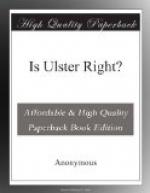But whilst Ulster was growing calmer, the condition of the south was becoming daily more appalling. On the 23rd of May the rebellion actually broke out in the counties of Dublin, Kildare and Meath; and many skirmishes took place in which the losses on the king’s side were comparatively few but those of the rebels enormous, in consequence of their ignorance of the use of firearms. The better-trained forces soon got to know that an Irish peasant when armed with a pike was a deadly foe; but when armed with a musket was almost harmless. This part of the campaign will always be specially memorable for the attack made on the little town of Prosperous, in the county of Kildare. It was cleverly made in the early morning; the garrison, taken unawares, were nearly all killed; the Commander, Captain Swayne, being amongst the victims. It was soon afterwards found out that the leader of the rebels was Dr. Esmonde, a gentleman of good family, and first lieutenant in a regiment of yeomanry stationed a few miles off, who had been dining with Captain Swayne the previous evening. He appeared in his regiment the next day, but was identified by a yeoman who had seen him at Prosperous; arrested, tried, and hanged as a traitor.
A Nationalist has recently referred to him as a martyr to the cause of Irish liberty.
By the month of June Wexford had become the centre of the rebellion. In that county it had assumed an essentially religious character (there being, however, a few exceptions on each side), and in no other part of Ireland was the war so terrible either on account of its magnitude or barbarity. The passions of the ignorant peasantry were inflamed by all Protestants being spoken of as Orangemen and a report being diligently circulated that all Orangemen had sworn to destroy the Catholic Faith—exactly the same course that was followed a hundred years later. Roman Catholic priests, wearing their sacred vestments and carrying crucifixes, led the rebel forces; and the ignorant peasants, believing them to be endowed with miraculous powers, followed them with the blind adherence that only fanaticism can inspire. And yet—so strangely contradictory is everything in Ireland—there is clear evidence that amongst those priestly agitators many were at heart deists, who were making use of religion in the hope of furthering Jacobinism. Many Protestants saved their lives by apostatizing, or by allowing their children to be rebaptized; it is but fair to add, however, that several of the older priests, shocked at the conduct of the rebels, concealed heretics in their houses and churches; and that all through the war many priests, in spite of the difficulty of their position, remained loyal and did what they could to aid the king’s troops.
The rebels for some weeks held command of the town and county of Wexford, their chief camp being at a place called Vinegar Hill. The country around was searched and plundered; the Protestants who were captured were brought into the rebel camp, and there deliberately butchered in cold blood. How many perished it is impossible to say; the number must have been at the least 400.




